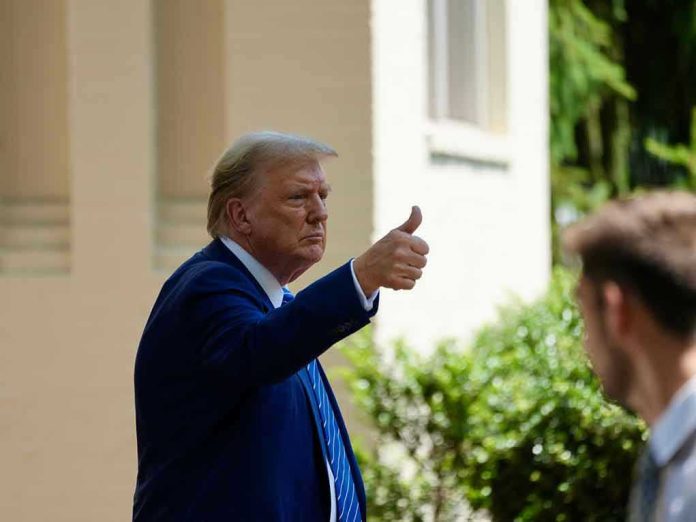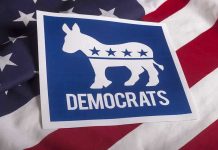
What if the next check the government mails you has “Tariff Dividend” stamped across the top—and the signature is Donald J. Trump?
Quick Take
- Trump vows to send $2,000 checks funded by tariff revenue to most Americans, excluding high-income earners.
- No details exist about how payments would work or whether Congress would approve them.
- Experts warn that tariffs often raise consumer prices and funding payouts with them could worsen inflation.
- The Supreme Court’s pending decision on Trump’s tariff authority could make or break the proposal.
Trump’s $2,000 Tariff Dividend: A Campaign Rallying Cry
Donald Trump fired a shot into the economic debate by promising a $2,000 “tariff dividend” for most Americans, funded by what he describes as “trillions of dollars” in tariff revenue. Instead of the usual tax refund or pandemic stimulus, Trump wants to use tariff proceeds—traditionally earmarked for government operations—to send direct payments to citizens. The plan specifically leaves out high-income earners, a move that adds a progressive twist to a policy tool usually criticized as regressive. Trump’s announcement, made on Truth Social in November 2025, comes as he seeks to realign the populist economic message that defined his earlier presidency. The pitch: tariffs aren’t just a tool to hurt foreign competitors—they’re a pot of gold that could land right in your mailbox.
By framing tariffs as a windfall for ordinary Americans, Trump distinguishes his pledge from the typical government handout. Yet, the proposal is long on bravado and short on details. He’s offered no specifics on eligibility, distribution, or how exactly “trillions” will be collected, especially since recent Treasury data put annual tariff revenue in the tens of billions, not trillions. With no bill introduced in Congress and no sign of executive action, the $2,000 check remains a campaign promise rather than a policy in motion. The timing is strategic: Trump’s declaration coincides with legal skirmishes over his use of the International Emergency Economic Powers Act (IEEPA), now under Supreme Court scrutiny. If the Court narrows presidential tariff authority, the very foundation of Trump’s plan could vanish before the first check is printed.
Tariffs as a Revenue Source: Historical Context and Modern Controversy
Tariffs were once America’s bread and butter, funding the federal government before the income tax era. In recent decades, they’ve served as a lever for trade disputes more than as a revenue engine. During Trump’s first term, tariffs on steel, aluminum, and a raft of Chinese goods spiked annual collections to over $80 billion—still a far cry from “trillions,” but enough to spark the imagination of campaign strategists. Traditionally, tariff revenue flows into the general Treasury, helping pay for everything from highways to homeland security, not for individual payouts. The only American precedent for something similar is Alaska’s oil dividend, which annually shares a chunk of state oil profits with residents. Trump’s proposal, however, would mark the first time federal tariff revenue is earmarked for direct payments to the public.
His plan arrives in a climate of economic anxiety, marked by inflation and skepticism about whether tariffs help or hurt everyday Americans. Critics argue that tariffs function like a tax on consumers, raising prices on imported goods from smartphones to sneakers. Supporters counter that tariffs protect American jobs and industries. The prospect of a direct dividend aims to flip the script: what if tariffs could put cash in your pocket, not just drive up your grocery bill?
Legal and Legislative Hurdles: Will This Check Ever Arrive?
There is one glaring catch: even if Trump returns to office, he cannot unilaterally mail out tariff dividend checks. Congress holds the purse strings and would need to pass legislation authorizing and funding such a payout. Currently, no bill has been introduced. Meanwhile, the Supreme Court is weighing the legality of Trump’s past use of IEEPA to impose sweeping tariffs. Legal scholars are split; some say the law grants broad authority, others contend Trump overstepped his bounds. If the Court sides with the latter, the legal underpinnings for future tariff windfalls could collapse.
Congressional reaction has been mixed. Some Republicans see political gold in Trump’s idea, especially among working-class voters feeling left behind by globalization. Democrats, on the other hand, dismiss the plan as fiscal fantasy, warning of inflation and international backlash. The Biden administration has so far refrained from responding, likely wary of lending the idea credibility before the courts and Congress weigh in.
Economic and Political Impact: Windfall or Mirage?
Economists and policy experts see the proposal as a populist masterstroke with hidden landmines. Many warn that tariffs act as a regressive tax, disproportionately harming low-income households through higher prices, even as a dividend offsets some of those costs. Direct payments could boost consumer spending in the short run but risk fueling inflation if funded by higher tariffs on everyday goods. Trade policy specialists at institutions like the Peterson Institute caution that using tariffs for payouts could antagonize trading partners, invite retaliation, and destabilize global markets. Legal thinkers note that the Supreme Court’s IEEPA ruling will set the boundaries for what any future president can do with tariffs—direct dividends or otherwise.
For now, Trump’s $2,000 tariff dividend is more campaign sizzle than policy steak. Yet, it signals a new chapter in the debate over how trade policy should serve American families. Whether the plan materializes or fizzles, it lays bare the shifting ground of economic populism and the unresolved tension between protectionism and prosperity. The next move belongs to Congress and the Supreme Court—and perhaps, in the end, to American voters who must decide if they want their next windfall stamped “Tariff Dividend.”
Sources:
CBS News: Trump’s $2,000 Tariff Rebate Check—What to Know









